
Do you have a favorite comic book or cartoon character that you have stayed with even though they changed over the years? In some cases the change was due to a storyline. Those that follow Marvel's X-Men characters are fluent with the number of lineup and costume changes they have had. Some characters became injured or grossly disfigured and had to undergo a visual makeover by the artist over a stretch of issues. Many fans can pinpoint a favorite iteration of Wolverine or Storm for example. Some attribute a specific look to a certain artist. Some characters change simply because the popular aesthetic changes over time as well. For example the comic book characters of the 1970s were not drawn the same as those from today. Fans could still make out Wolverine and Storm but they looked different simply because of the aesthetic of the era. Even the most famous cartoon characters are not immune to change. The "rubber hose" animation from the silent film era was refined over half a century until animators learned how to create the illusion of weight and mass on a two-dimensional object. The purpose of this series is to see how my favorite Disney cartoon character changed over the years and yet managed to return to his original aesthetic. Before we talk about the changes we have to learn what made the character worth remembering.
Oswald the Lucky Rabbit was the forefather to Mickey Mouse. Many Disney fans could tell you the origin of the character and many of the things that made him memorable. Oswald, like his more famous successor, spoke to the every-man. He wasn't born into money but was instead a hard working character. This was an important detail because while a handful of Americans were making obscene riches during the Gilded Age, there were also many living on the edge of ruin. The Wall Market crash of 1929 destroyed the economy and with it the hopes of many Americans. Those people were looking for a reason to smile during the turbulent era. Oswald and later Mickey Mouse were those reasons.
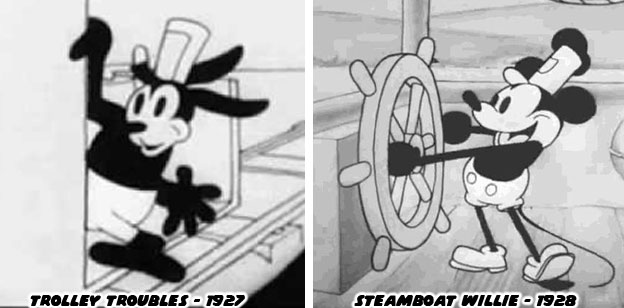
The two characters worked for a living but were content even when unemployed. That happy-go-lucky attitude was a big draw. In the first case Oswald operated a Trolley. A year later Mickey Mouse was featured as a steam ship pilot. Oswald's first completed cartoon was not Trolley Troubles but it was the first one shown to audiences. Just as in the same way Mickey's first cartoon was not Steamboat Willie but it was the first shown to audiences. During that time the look of Oswald had not been set. It did not matter what the character looked like because there were many memorable scenes in that film that kept audiences coming back. There was tremendous comedic timing from the rabbit that was showcased in the following cartoons. He could defy physics, swim through the air, pull his leg off, break into small pieces and put himself back together again. Many were gags pioneered by animator Ub Iwerks, Walt Disney and the staff at the fledgling Laugh-O-Gram animation studio.
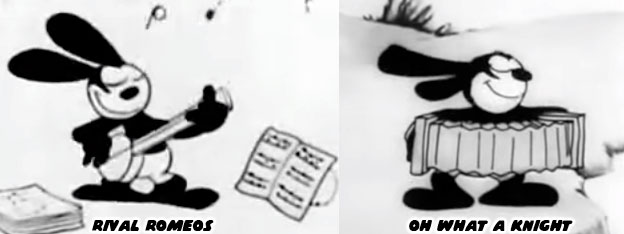
Where Oswald really shone was when he was romancing a girl. In some instances it was a female rabbit while in other shorts it was Ortensia the cat. It was as if there was nothing that was impossible for Oswald. He was truly a great leading man especially when he was trying to win the affections of his co-star. In addition to being an every-man Oswald was a bit of a musician. In a couple of his earliest appearances he could be seen trying to woo his girlfriend with a musical number. Unfortunately for the rabbit sound synchronization in animation had not yet become available to Walt Disney. Audiences had to use their imagination and guess that the sound of the theater organist was also a banjo or accordion.
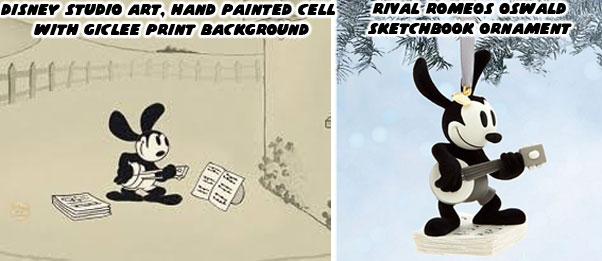
It had been well over 80 years since Oswald had been seen playing a stringed instrument in Rival Romeos yet somebody at Disney had been doing their homework. One of the first collectable pieces of art that the studio produced after getting the rights back from Universal was a hand painted cell that rekindled that scene. A few short years later the company released a brilliant Christmas ornament celebrating the same scene. Yet it was not all smiles and music that made Oswald an important character. Oswald was absolutely the template for Mickey Mouse. Every detail that made Mickey a household name was pulled from Oswald. Both characters had a broad range of emotions. Both were playful but also prone to getting upset. In fact they were willing to get into fights if the situation called for it. This gave both dimension and made it easier for audiences to identify with them. It would be something that the Disney and Universal would get away from as Oswald and Mickey Mouse grew in popularity.
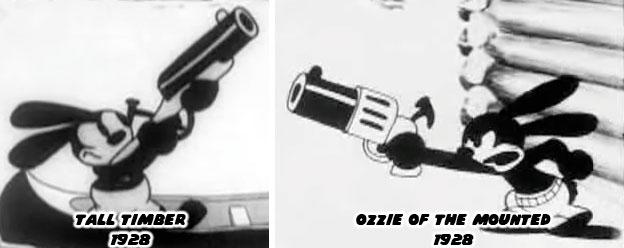
The personality of Mickey Mouse would be stripped away little by little. His temper would be assigned to Donald Duck. His silly side would be given to Goofy and his loyalty to Pluto. By the '60s Mickey was devoid of any real range of emotions. He had become the face of the company and a family-friendly one that that. Oswald would become a mascot devoid of any real personality as the years went on. His traits would not really be transferred onto other characters created by the Lantz animation studio. Well, to be honest some of the silliness is reflected in the characteristics of the early Woody Woodpecker cartoons. The studios wanted audiences to forget that Oswald, Donald and even Mickey pulled guns in a cartoon. Yet that ability for the character to do something drastic also made them memorable. The characters did not fight for the sake of violence, if they did it was in self defense, usually when standing up to bullies. Nor did they resort to a firearm unless the situation, or the gag, called for it. Unfortunately for Walt he did not have Oswald long enough to see him develop into a real icon. As many Disney fans know Walt lost the rights to Oswald. Universal took the rabbit and even a great chunk of Walt's animators out from under him. His senior man Ub Iwerks stayed with him and helped Disney finish the remaining shorts that they were contractually obliged to produce.
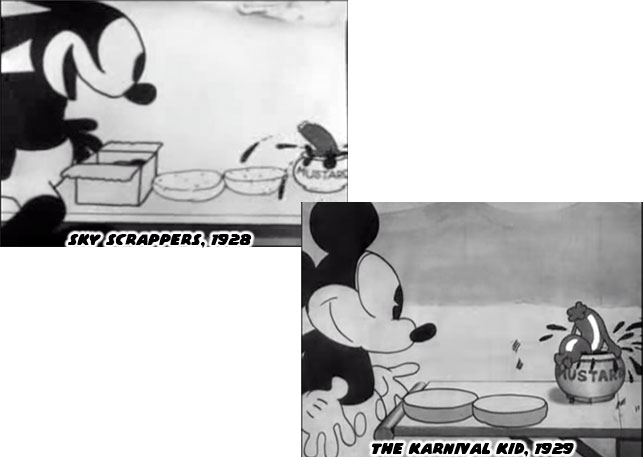
Something that Ub and Walt did was try and improve on the gags they were using in their final Oswald shorts. They began using some of the same set-ups for the early Mickey Mouse cartoons, which they were creating in secret. During this time Ub was creating hundreds of frames of art each and every day. At his peak he as pulling out 700 drawings a day, enough for a cartoon every two weeks. Ub understood the mechanics of animation, of perspective and timing. He was a natural at the art form and a master draftsman. He created many memorable gags for the early Oswald shorts as well. Some of the better ones he was willing to reuse for Mickey Mouse.
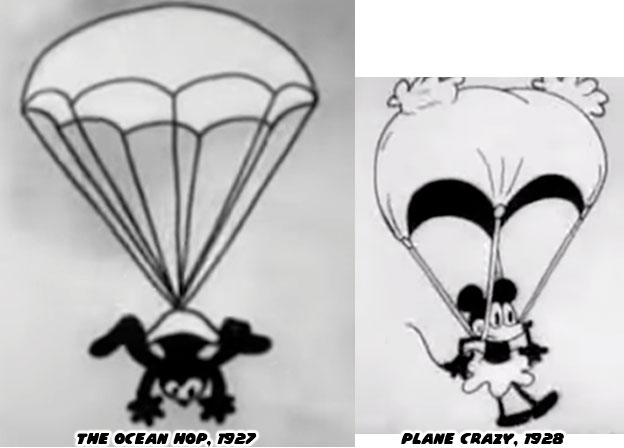
Some of the gags that the former Laugh-O-Gram animators had planned out for Oswald while he was at Disney eventually found their way into the later Walter Lantz animated films. One of the rarest Oswald films, Harem Scarem was lost to time. No known print exists but a few sketches from Ub do which the Disney Archive was kind enough to showcase at a D23 fan event. One of the visual gags had Oswald losing his balance while raiding atop a camel. A few years after Harem Scarem Universal released a sound film featuring Oswald called Oswald Goes to Africa. The gag had changed slightly to make use of sound but it was reminiscent of Ub's original designs.
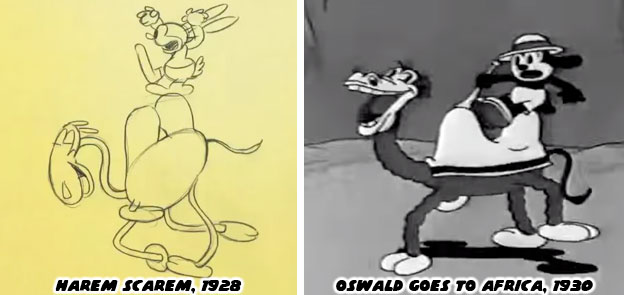
Walter Lantz worked for Universal and was starting up his own animation studio. He had some of the animators that worked with Disney previously and were familiar with the rabbit. What he needed was a mascot to build his studio around. He won the rights to Oswald in a card game against Universal producer Carl Lammle. He stayed with the studio and produced the majority of Oswald's animated adventures in the following years. What he also did was give the character a radical makeover. We will explore this more in the next blog.
If you would like to sponsor me
please visit my Patreon page and consider donating each month, even as little as $1 would help make better blogs and even podcasts! 







Walter Lantz Oswald was way better.
ReplyDelete